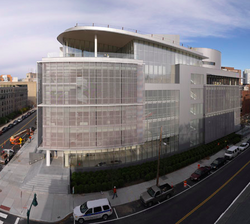CIRCA:MIT Media Lab
From CIRCA
The MIT Media Lab is a research laboratory of the Massachusetts Institute of Technology located in Cambridge Massachusetts. A part of the University's School of Architecture and Planning, the MIT Media Lab is an interdisciplinary research group dedicated to investigating the potential uses and effects of technology, multimedia, and design. Currently, there are over 170 researchers at the Media Lab, including 28 permanent faculty and principle investigators, working on over 350 projects. Over 70 sponsors fund the Lab's annual $35 million budget.
Opened in 1985 as the brain child of professor Nicholas Negroponte and former MIT president Jerome Wiesner, the lab occupied the specially designed Wiesner building on the University's main campus. Initially, the Media Lab had a 10 year mission exploring the uses and implications of the technologies of the emerging "digital revolution". Projects sponsored under this mandate include research into holography, electronic music, and cognition and learning. After its first decade, the lab shifted its focus to investigating digital technologies outside of the traditional "box" computer. Areas of research during this time included novel approaches to children's education, wireless communication, and new forms of artistic expression.
After it's 20th anniversary the MIT Media Lab has begun to its work on "human adaptability", with areas of research ranging from Alzheimer's treatments to new methods for Human Computer Interaction. In 2009, the Media Lab opened a six story connected expansion of the Wiesner building to form the MIT Media Lab Complex.
Facility
The Media Lab is currently housed in a 163000 square feet (approximately 15100 square metres) six story complex, opened in 2009. The building houses laboratory, office, and meeting space as well as the List Visual Arts Centre, The School of Architecture and Planning's Programme in Art, Culture, and Technology, the Comparative Media Studies Programme, as well as the Okawa Centre for Future Children.
The building was built in an open atelier, adaptable style in order to address the demands of changing research demands. The use of open space and glass walls is meant to encourage collaboration between research groups and investigators. The building features:
- 7 research laboratories of sizes ranging from 5000-8500 square feet (approximately 460-790 square metres)
- 8 conference rooms
- Inner and Outer atrium, both flanked by exhibition space
- 1 cafe and 2 small coffee areas
- 3200 square feet (approximately 300 square metres) of administrative space
The top floor is dedicated to being used for events and features:
- A 100 seat lecture theatre
- A 3500 square foot (approximately 325 square metres) multipurpose space
- A 2500 square foot (approximately 230 square metres) conference room featuring an outdoor terrace
- A 3500 square foot reception/dining area
- A 1800 square foot (approximately 170 square metres) catering kitchen.
Current Projects
The MIT Media Lab has 25 research groups overseeing the development of over 350 projects. Some examples of current projects are:
- Scratch - A programming language and development environment aimed at children to teach the fundamentals of Computing Science.
- Sourcemap - A visualization tool to allow people to see where all the components of the products they use everyday are sourced, shipped, and manufactured.
- Selectricity - A voting system designed to make better informed decisions easier.
- Processing - An open source programming language and development environment for those who wish to make images, animations, and interactions.
- Personas - A visualization tool used to create an identity based on information available about a specific person online.
- Outbreaks Near Me - A smartphone app dedicated to utilizing HealthMap data to inform a user about potential disease outbreaks near them.
- Common Sense Computing Initiative - An effort to allow computers to know things that people do, but might not realize.
- Minecraft Print - A program that prints items created in Minecraft via 3D printers.
Notable Projects
The Media Lab has over the years become very well known for its successful projects and spin-offs, which have been featured in well known publications like Wired and Red Herring. Examples of successful and well known projects and spin-offs include:
- Scratch
- Harmonix Music - Creator of the popular video game series Frequency, Guitar Hero, Rock Band, and Dance Central.
- E-Ink - The technology currently used in many eReaders including the Amazon Kindle.
- One Laptop Per Child - An initiative to create a rugged affordable $100 laptop that can be sold and used by children in developing countries.
- Potion Design - A design firm that specialize in new Human Computer Interaction methods.
- The Echo Nest - An intelligent music platform that can analyze music, current musical trends, and what people are saying about music. Currently used by MTV, the BBC, Warner Music Group, and independent developers.
- The MPEG-4 Audio standard, currently adopted by the ISO
MIT Media Lab technology has also been adopted and used by major companies including LEGO (LEGO Mind Storms), Visa and Mastercard (The Benton Hologram), Google (Google Street View), and IBM (The Pointing Stick).


